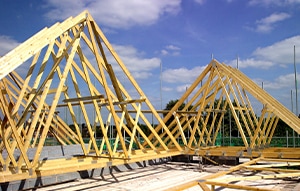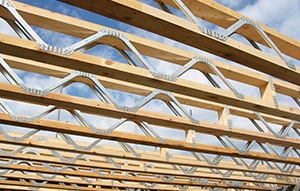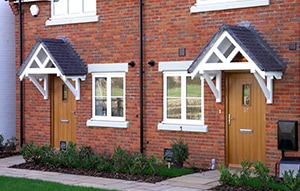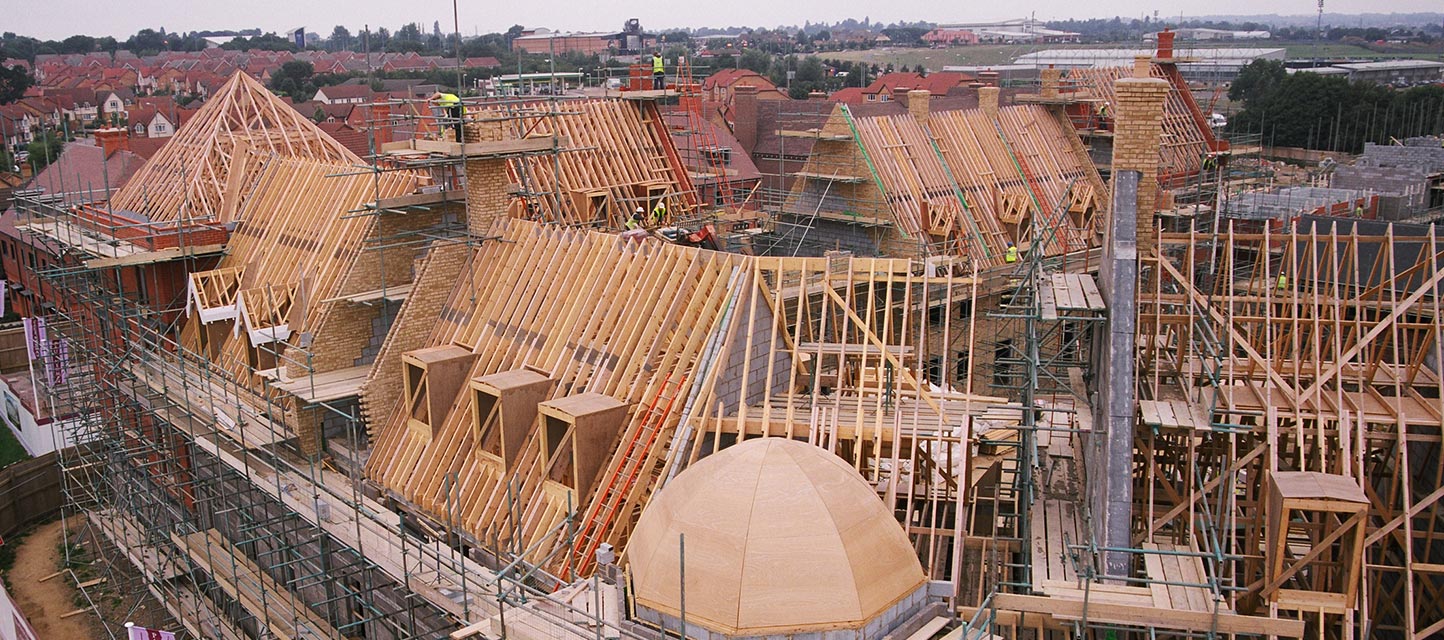How to Safely Store Roof Trusses Onsite
The safe onsite storage of roof trusses, also known as trussed rafters, is key to ensuring the quality and maintenance of these roof components. Trussed rafters can be safely stored vertically or horizontally at ground level. It is best to store trusses with “tails” (overhangs) so truss weight does not rest on tails.
How to store Trusses
Storing roof trusses on a construction site is a crucial part of ensuring they remain structurally sound and ready for installation. Here are some steps to follow when storing roof trusses on-site:
-
Select the Right Location:
Start by choosing an appropriate location on the construction site for truss storage. Look for a flat, well-drained area that is clear of debris, rocks, and any other potential hazards. The chosen area should provide a stable foundation for the trusses.
-
Elevate the Trusses:
It’s important to keep the trusses off the ground to prevent direct contact with moisture. Use wooden blocks or similar supports to elevate the trusses. This will reduce the risk of rot or rust developing on the trusses’ bottom surfaces.
-
Protect from the Elements:
Roof trusses are vulnerable to damage from rain, snow, and direct sunlight. Cover them with tarps or weatherproof material to shield them from the weather. Ensure that the coverings are securely fastened to prevent wind from lifting them and exposing the trusses.
-
Stack Trusses Neatly:
When stacking trusses, do so neatly and evenly. Avoid overloading the stack, as excessive weight can lead to damage to the trusses at the bottom of the pile. Proper stacking helps prevent twisting or warping.
-
Provide Ventilation:
Allow for adequate ventilation between the trusses. Good ventilation prevents the accumulation of condensation, which can lead to moisture-related problems over time.
-
Label and Organise:
Label each truss clearly for easy identification. Organise the trusses in a way that allows you to access the specific ones you need for installation without disturbing others in the stack.
-
Protection from Construction Activities:
Make sure that the stored trusses are protected from construction activities. Heavy equipment or materials should not accidentally damage them. Create a designated area for truss storage that minimises the risk of interference.
-
Regular Inspections:
Periodically inspect the stored trusses for any signs of damage or moisture. Address any issues you discover promptly to prevent further deterioration.
Properly storing roof trusses on-site is essential to protect your investment and ensure that they remain in good condition until they are ready to be installed in the building.
Delivery of roof trusses
The delivery of roof trusses should be arranged as close to the installation date as possible to minimise storage onsite. At Scotts Timber Engineering, we work on a “just in time” basis to reduce your need for long-term storage and keep your trusses in top condition for longer. However, if longer periods of time are required, the following steps must take place:
Site storage of roof trusses
Roof trusses must be stored safely to minimise injury onsite and to prevent any damage to the trusses. Roof trusses can be stored vertically or horizontally at ground level, or, alternatively, on a secure storage platform above ground level. In either case, the roof trusses must not make direct contact with the ground or any vegetation.
They must be arranged to avoid distortion and restrained securely to avoid collapse. Roof trusses should also be protected with covers and stacked correctly to allow proper ventilation. When storing your trusses you need to ensure that they are protected from the elements and should never be left in an area that is damp or in or near water.
Storing roof trusses vertically
If you choose to store roof trusses vertically, bearers should be positioned to provide firm and safe support. Stacking should be carried out against a firm and safe support or by using suitable props.
Can roof trusses get wet?
Wood trusses can become wet due to exposure to moisture. During construction, they may be exposed to rain or other forms of moisture. While this is generally not a problem, it’s essential to allow them to dry thoroughly before covering them with roofing materials. Proper storage and protection during construction are vital to prevent long-term damage.
Additionally, roof leaks or other sources of water infiltration can lead to moisture exposure for wood trusses. This can result in issues like rot, which can weaken the trusses over time if not addressed promptly.
Condensation is another concern, particularly in colder climates. Warm, moist indoor air can come into contact with the cold surfaces of wood trusses, leading to moisture accumulation. Adequate insulation and ventilation are important to mitigate this problem.
Regular maintenance and inspections are essential to identify and address any moisture-related issues promptly, preventing long-term damage to wood trusses.
How long can trusses be stored outside?
As previously discussed, Trusses can withstand some weather exposure while they are being built, but the TRA does not advise doing so for longer than four weeks since prolonged exposure to repeated wet/dry cycles may weaken the trusses. Typically, roof trusses should not be stored outside for extended periods without proper protection. Exposure to the elements, especially moisture and direct sunlight, can have a detrimental effect on the trusses’ structural integrity and may lead to issues such as warping, twisting, or damage to the truss plates.
Storing roof trusses horizontally
If you choose to store roof trusses horizontally, level bearers should be positioned between each truss node to prevent any distortion.
Please note, no other method of storing roof trusses is suitable, except for specific provision being included in the design for an alternative temporary load case.
At Scotts Timber Engineering we ensure your roof trusses are delivered to site as close as possible to the installation date to reduce storage time on site. It is important for the builder or site crew to ensure that a suitable level and dry area is available for unloading to ensure that the trusses are in the best possible condition. Safe unloading and installation guidance is provided as standard. We recommend that the builder should ensure timber battens are fixed across the bundle in several locations before the removal of the bands. This is to avoid destabilisation of the bundle and will allow the safe removal of single trusses once the bands are removed.
For further information please see page 13 of the Trussed Rafter Association’s Buyer’s Guide to Trussed Rafters.
Contact our team of experts who are always ready to offer guidance and expertise, ensuring a seamless and stress-free experience for every client.
Click the link to fill out our contact form or call us on 01832 732366.
If you would like to speak to one of our team, simply fill out your details below and a member of our sales team will be in touch very soon to discuss your project requirements.
If you would like to speak to one of our team, simply fill out your details below and a member of our sales team will be in touch very soon to discuss your project requirements.
- Copyright © Scotts of Timber 2024
- Privacy Policy




















